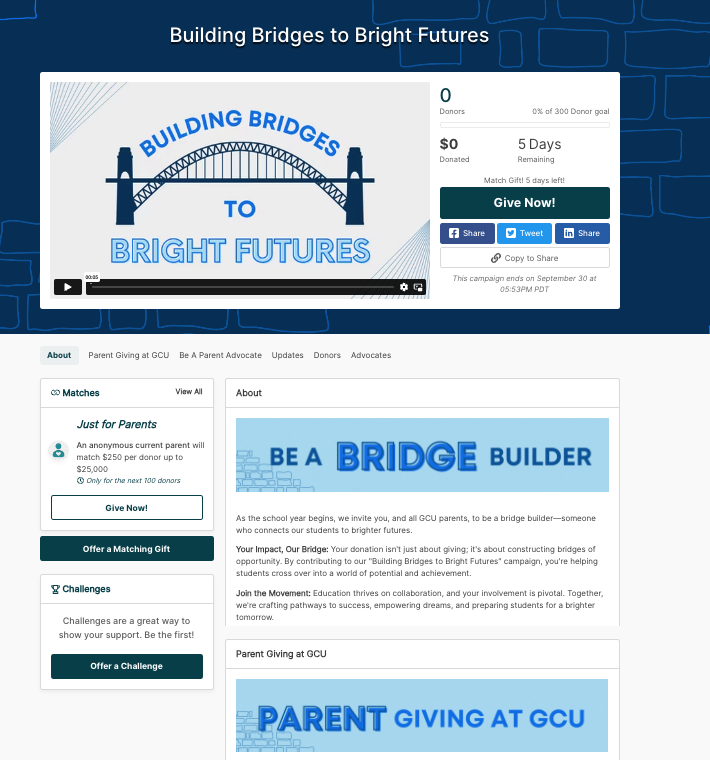In today’s ever-evolving fundraising landscape, technological advancements have become catalysts for transforming how people raise money. Among these innovations, artificial intelligence (AI) stands out. While human work will always be the driving force behind successful fundraising, AI can be leveraged to simplify workflows and improve productivity.
The field of AI encompasses many facets from generative AI to machine learning to natural language processing–many of which can be applied to the educational fundraising space. This guide, however, will take a closer look at leveraging generative AI in fundraising.
At the core of this technology are AI prompts. These often simple commands are the key to activating generative AI tools like ChatGPT and Google Bard to produce personalized content, campaign ideas, marketing plans, and more. But, not all prompts are created equal. Tailoring your prompts so they result in a high-quality output is a skill within itself.
Below, we’ll explore AI prompts in the context of educational fundraising and provide some sample prompts for you to experiment with.
Generative AI Best Practices
Integrating AI prompts into your fundraising campaigns can be a game-changer, but it’s important to do so thoughtfully and strategically. Below are some best practices to keep in mind.
1. Strategically Integrate AI Prompts
When incorporating AI prompts into your fundraising efforts, start with a clear strategy. Define your campaign’s objectives, target audience, and the specific messages you want to convey. This strategic foundation will guide how you tailor the example AI prompts below to fit your institution’s needs.
2. Maintain Authenticity
While generative AI can save time and effort, it should never compromise the authenticity of your messages. Inject your organization’s unique voice and values into AI-generated content to maintain a genuine connection with your donors. A personal touch goes a long way in building trust and rapport.
3. Test and Refine
Generative AI tools like ChatGPT and Bard learn and improve over time. If a particular prompt doesn’t give you the content or result you were looking for, try refining the information you input. Provide additional details about your audience, desired tone, content length, and goals to get an output more closely aligned with what you were looking for.
4. Blend AI with Human Creativity
Generative AI tools are meant to enhance human creativity, not replace it. Use AI-generated content as a starting point, and then infuse your team’s creativity to make the messages more engaging and emotionally resonant. This combination of AI efficiency and human insight can lead to compelling content.
5. Continuous Learning
It’s important to stay updated with AI advancements and developments as it is a rapidly changing field. As AI technology evolves, new capabilities may emerge that can further enhance your fundraising efforts. Continuously learn and adapt to stay ahead of the curve.
Sample AI Prompts for Educational Fundraisers
Below are a variety of example prompts that demonstrate how generative AI can assist educational fundraisers across different facets of their work. As mentioned above, these examples should serve as inspiration to help you harness the power of AI effectively. You’ll notice some of them reference additional details you will need to include based on your institution and initiatives. Below the examples are tips on how to craft your own prompts tailored to your institution’s goals and donor base.
Campaign Planning
When embarking on a fundraising campaign–whether it be an annual Giving Day or targeted email communications for a specific constituent segment– strategic planning is key. Here are four generative AI prompts to kickstart your campaign planning process:
- “Generate a brief elevator pitch outlining the goals listed below and the desired impact of our school’s next fundraising initiative to run by the VP of Advancement [insert list of campaign goals].”
- “Craft a captivating tagline for an upcoming Giving Day that encapsulates the school motto [insert school motto].”
- “Write an engaging teaser paragraph for a campaign announcement [insert campaign name and details] that sparks curiosity and anticipation.”
- “Develop a 6-week social media marketing strategy to promote an upcoming Giving Day campaign.”
Donor Engagement
Engaging donors requires personalized and meaningful interactions. These prompts focus on creating AI-generated content to foster donor engagement:
- “Using the details below, draft a thank-you email to acknowledge a recent donor’s contribution and share the immediate impact of their support. [insert donor details such as name, affiliations, donation campaign, etc].”
- “Write a personalized follow-up message for potential donors who have expressed interest but haven’t yet contributed.”
- “Craft a series of anniversary-themed messages to celebrate donors’ ongoing commitment to your cause and use in anniversary campaign solicitations.”
- “Develop five social media post templates for donors that can be tailored to highlight their reasons for supporting your institution.”
Solicitation
Soliciting donations requires persuasive communication that resonates with potential donors. Here are prompts to assist in crafting compelling solicitation messages:
- “Generate a compelling email subject line that encourages possible donors to open a donation request email.”
- “Write a persuasive paragraph highlighting the urgency of a funding need in a specific department or project.”
- “Craft a donation request tailored to alumni, focusing on their shared experiences and the lasting impact they can make.”
- “Develop a phone call script to help guide volunteers’ conversations with potential donors. Create versions for speaking with the following segments: alumni, parents, and community members.”
Generative AI can also be a helpful tool for drafting the messaging for a campaign page.
Here’s an example campaign page GiveCampus created using ChatGPT:

Stewardship
Stewardship is essential to maintaining donor relationships. Use these prompts to enhance your stewardship efforts:
- “Write a warm and personal thank-you letter to acknowledge a significant donor’s generous contribution.”
- “Generate a social media post that highlights the outcomes achieved thanks to gifts from a recent campaign”
- “Craft a progress update email to keep donors informed about the impact of their contributions on ongoing projects.”
- “Generate a script that can be personalized and tailored for students to use in thank-you videos for donors.”
Writing Your Own Prompts: Anatomy of a Successful AI Prompt
The sample prompts above are a good starting point but will need to be refined to generate the best output for you and your team. Crafting effective prompts involves a thoughtful approach that combines clear communication and strategic guidance. Below are some key elements that constitute a successful AI prompt–whether you are tailoring one of the prompts above or starting from scratch.
1. Be Clear and Specific
Clearly outline the context, topic, or task you want the AI to address. For instance, if you’re seeking a compelling campaign slogan, specify the campaign’s theme, target audience, and desired tone. A clear prompt sets the direction for the AI’s response.
2. Set the Right Tone and Style
Whether it’s formal, informal, persuasive, or narrative, guide the AI by indicating the voice you want the content to embody. Providing this direction helps align the AI-generated content with your institution’s brand and messaging. Don’t be afraid to be hyper-specific when indicating the tone. Some example tones to try are: conversational, humorous, academic, professional, sincere, persuasive, or quirky.
3. Offer Examples or Templates to Guide the Response
For example, if you’re requesting an impact narrative, provide a sample story structure to guide the AI’s composition. Templates act as a framework, helping the AI generate content that fits the desired format.
4. Ask Open-Ended Questions
Phrase your prompt as an open-ended question to encourage a detailed response. Instead of asking, “Write a thank-you note” ask “Can you craft a heartfelt thank-you note that emphasizes the lasting impact of donors on students’ lives?”
5. Experiment and Refine
As mentioned above, there will likely be some trial and error as you and an AI tool get acquainted. Experiment with variations of prompts to find the wording that yields the best results. Try different tones, include an additional example, or specify a word count. If the initial AI response doesn’t align with your goal, tweak the prompt iteratively until you achieve the desired outcome.
Beyond AI Prompts– Exploring the Role of AI in Fundraising
Hopefully, these tips and templates help you feel more comfortable integrating generative AI into your work processes. These prompts are just the tip of the iceberg when it comes to how AI may impact how we do work in fundraising and beyond.
Many of our examples above are relevant specifically to fundraisers involved in annual giving or donor relations. Are you curious about how AI can help other educational fundraising roles?
GiveCampus offers a free AI-powered utility to help with one of the most tedious, but essential, tasks of major gift officers–writing contact reports.
Contact Reports AI transforms raw notes from donor interactions into a polished contact report with recommended next steps and suggested follow-up message–all in a matter of seconds. The best part? Anyone can try the solution for free!
